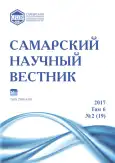Laboratory diagnosis of trade animals’ trichinosis
- Authors: Andreyanov O.N.1
-
Affiliations:
- All-Russian Research Institute of Fundamental and Applied Parasitology of animals and plants named after K.I. Scriabin
- Issue: Vol 6, No 2 (2017)
- Pages: 10-14
- Section: 03.02.00 – General Biology
- URL: https://journals.rcsi.science/2309-4370/article/view/21787
- DOI: https://doi.org/10.17816/snv201762101
- ID: 21787
Cite item
Full Text
Abstract
In this paper the author considers the possibility of using an automated method of diagnostics of the causative agent of trichinosis Trichinella spp. at wild trade animals. In the course of trichinosis monitoring in the Central region of Russia naturally infested carcasses of animals were selected. The infected animals were stored at a low (-5°C) temperature in the climatic camera before carrying out researches. With the help of AVT devices diagnostic tests on trichinosis of different types of trade animals’ muscular tissue samples (diaphragm, masseter, extremities muscles, tongue) were conducted. During the research refrigerated and later cooled muscles samples were used. Samples weighing 50±0,5 g. were used for the research. To get qualitative mincemeat fat and connective tissue were removed from muscular tissue. Pepsin produced by «Shako» (Rostov region) was used for an artificial peptoliz. Diagnostic samples of boars, foxes, martens increased the weighing mass to 40 minutes, of wolves to 50 minutes and of raccoon dogs to 60 minutes. Further tissue was fermented and weighing mass of the researched samples was decreased. The optimal period of time was found for trichinellascopy test of wild animals’ muscular tissue by the automated method on AVT devices.
Full Text
##article.viewOnOriginalSite##About the authors
Oleg Nikolayevich Andreyanov
All-Russian Research Institute of Fundamental and Applied Parasitology of animals and plants named after K.I. Scriabin
Author for correspondence.
Email: 1980oleg@mail.ru
doctor of veterinary sciences, senior researcher of Parasitic Zoonosis Laboratory
Russian FederationReferences
- Малышева Н.С., Самофалова Н.А., Власов Е.А., Вагин Н.А., Елизаров А.С., Борзосеков А.Н., Гладких К.А. К вопросу об актуальности изучения аляриоза (мезоцеркариоза) на территории Курской области // Ученые записки: электронный научный журнал Курского государственного университета. 2013. № 3 (27). Т. 1. 5 с.
- Кротенков В.П., Буренков С.Н. Мониторинг паразитарных заболеваний кабана в охотничьих хозяйствах Смоленской области // Теория и практика борьбы с паразитарными болезнями: матер. науч. конф. ВОГ РАН. М., 2013. Вып. 14. С. 182-185.
- Андреянов О.Н., Успенский А.В., Горохов В.В., Хрусталев А.В., Бундина Л.А. Гельминтозоонозы промысловых плотоядных животных Центрального региона России // Теория и практика борьбы с паразитарными болезнями: матер. науч. конф. ВОГ РАН. М., 2016. Вып. 17. С. 25-26.
- Малышева Н.С., Самофалова Н.А., Вагин Н.А. и др. Особенности циркуляции возбудителей зоонозов на территории Курской области и риск заражения ими человека // Уч. зап. Электр. науч. журнал Курского гос. ун-та. № 3 (23). Курск, 2012. 5 с.
- Успенский А.В., Скворцова Ф.К. Метод ветеринарно-санитарной экспертизы мяса промысловых животных при паразитарных зоонозах // Российский паразитологический журнал. 2014. № 3. С. 151-156.
- Борисенко Н.Е., Кроневальд О.В. Ветеринарно-санитарная экспертиза продуктов убоя при выявленных инвазионных болезнях животных // Ветеринарно-санитарная экспертиза продуктов вынужденного убоя животных, при выявлении болезней и при изменениях, возникающих в процессе хранения мяса. Барнаул, 2006. С. 114-139.
- Скворцова Ф.К., Успенский А.В. Диагностическая эффективность АВТ-Л6 для выявления бескапсульных личинок трихинелл // Теория и практика борьбы с паразитарными болезнями: мат-лы докл. научн. конф. М., 2006. С. 375-378.
- Андреянов О.Н. Современные пепсины в диагностике трихинеллеза // Новые методы экспресс-диагностики микроорганизмов в медицине, фармации, ветеринарии и экологии: мат-лы всерос. науч.-практ. конф. 2015. С. 22-26.
- Успенский А.В., Бессонов А.С., Шеховцев Н.В., Гребенкин С.А. Методические рекомендации по применению аппаратов для выделения личинок при ветеринарно-санитарной экспертизе туш и мясопродуктов // Тр. Всероссийского ин-та гельминтологии им. К.И. Скрябина. М., 2005. Т. 41. С. 447-452.
- Гребенкина Л.А. Усовершенствование метода пептолиза с целью повышения эффективности трихинеллоскопического контроля // Российский паразитологический журнал. 2008. № 4. С. 57-59.
- Гребенкина Л.А. Послеубойная диагностика трихинеллеза животных: автореф. дис. … канд. биол. наук. М., 2010. 20 с.
- Андреянов О.Н., Скворцова Ф.К. К дифференциальной диагностике возбудителя трихинеллеза // Ветеринария: научно-производственный журнал. 2013. № 8. С. 32-36.
Supplementary files












